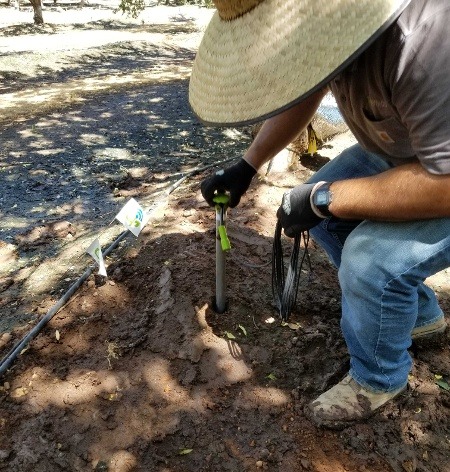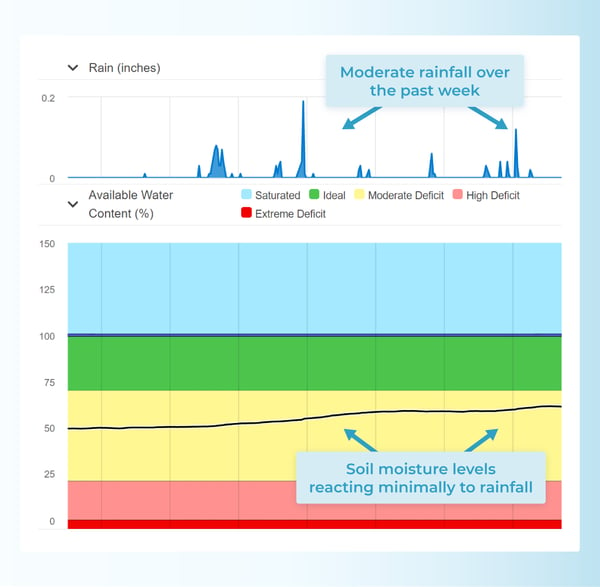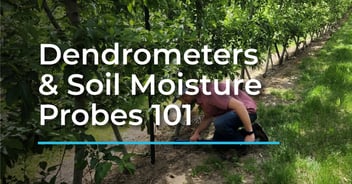4 Reasons Your Soil Moisture Sensors May Be Giving You Weird Readings
Soil moisture sensors are complicated pieces of equipment.
Everything from the installation to the calibration of the data is vital to making sure you get the most out of your investment.
While they can be an invaluable resource when it comes to managing your irrigation, they can also be a pain when exposed to the elements in the field. But you’re not alone.
In this blog, we review the most common sources of soil moisture probe problems and provide tips to get your readings back to proper working condition in no time.
How Accurate are Soil Moisture Sensors in Agriculture?
While many different types of soil moisture sensors or probes are used in agriculture, they all run on the same basic principle. A signal (usually electricity) is sent out into the soil, and a sensor measures the qualities of the signal that comes back to it.
Enough work has been done with each sensor type to give confidence in the accuracy of the raw data they provide. They are certainly more accurate than simply squeezing the soil with your hand and estimating moisture. And, there is little difference in side-by-side comparisons of separate sensors.
The most important questions for someone considering soil moisture sensors are:
- How easy are they to install?
- How much maintenance do they need?
- Can they be left in place, or do the measurements need to be taken manually?
- And even more important than sensor choice: what is done with the data to calibrate the readings after they are measured?
4 Common Causes of Bad Soil Moisture Sensor Readings
1. Data is Not Properly Calibrated
Data from soil moisture probes are generally returned as Volumetric Water Content (VWC). While the VWC is likely accurate, the data isn’t given in context.
Each soil’s VWC is kind of like its fingerprint. Each one is different and doesn’t relate to the others. Thankfully, VWCs can be related to the same standard by having the soil sent to a lab or, even better, by searching real-time data for a very distinct feature that indicates when the soil is filled to the point that it can’t hold on to any more water. This is called Field Capacity (FC).
After the data is calibrated to FC, it is called Available Water Capacity (AWC). There are a lot of acronyms to keep track of. Simply put, calibrated soil moisture data is called AWC. When you are receiving data as AWC, 100% means that the soil is full, and 0% means that there is no more water available to the plant.
 Example of raw soil moisture content data converted into a usable Available Water Content (AWC) chart on the Semios platform
Example of raw soil moisture content data converted into a usable Available Water Content (AWC) chart on the Semios platform
Most irrigation data providers have to calibrate the probes manually, which is very time-intensive. Because of that, many choose not to calibrate the data, while others use shortcuts that do not provide very accurate calibrations.
To combat this, Semios has developed a system that automatically calibrates the data. What’s more, the system doesn’t just calibrate once, it constantly looks for better data points that continually improve the calibration. With a system like this, you can be certain that the data you’re using is of the highest quality and is reliable for your most important decisions.
2. Improper Installation of the Soil Moisture Sensors
Installing soil moisture sensors is trickier than you might think. Some devices require a large excavated hole in order to hand-place a sensor at each desired depth. These are most commonly seen in greenhouses and research plots.
For commercial-use sensors in agricultural fields, most sensor manufacturers have developed sensors that slide nicely into holes drilled by specialty bits that bore out the perfect-sized hole.
 Semios Field Services Team helps install every one of our customers' soil moisture probes to ensure they're done correctly
Semios Field Services Team helps install every one of our customers' soil moisture probes to ensure they're done correctly
Even with easy-to-install sensors, there are some pitfalls to watch for when installing sensors:
- Placement in relation to the emitter: Semios technicians who install sensors have an extensive set of rules to follow to safeguard against this. There are two things to watch for. First, is the probe in a place representative of most of the field? Secondly, make sure to place the sensor where the water goes into the soil. It might be right beneath a drip emitter, or at the bottom of the berm if the water is running down the side of the berm.
- Air pockets when installed in the soil: Gaps and air pockets don’t transmit the signals from the sensor like soil would. Even in cases where you can create a tight hole to slide the sensor into, air pockets can form. It may be necessary to use the handle of a shovel or something similar to run down the side of the probe to fill in any gaps. Take care not to overdo it, as overly compacted soils cause other problems.
- Chance of being damaged: Make sure that the probe is out of the way of tillage equipment that will be passing through the field.
3. Rain Events
Unless you are in an area with frequent rain events, don’t count on rain to refill the soil.
A little-known fact about soils is that the wetter the soil, the slower it is to infiltrate water. That often means that rain wets the top ¼ to ½” of soil, and then the majority of the rest of the rain runs off the surface to collect in low areas and streams. Don’t be surprised, especially in heavy rain, to not see a large reaction in the soil moisture.
A good rule of thumb is that only 20% of rain actually infiltrates into the soil.
So, a 0.5” rainstorm would only add 0.1” of water to the soil. That small amount is almost negligible.

Example on the Semios platform of a case where the soil moisture levels in a field reacted minimally to rainfall
4. Equipment Issues
Electronics are not naturally suited for the kinds of conditions encountered in fields. A lot of work has gone into hardening the equipment to make it withstand extreme conditions, but there are still many things that can go wrong.
Intermittent signals are a common issue when there isn’t enough cell service in the area. But other issues can occur if wires are connected in the wrong order, or if a teething coyote pup decides to chew on the equipment. Often, this will completely cut off the signal, but sometimes, it can just temporarily impact the signal instead of cutting it off entirely.
Conclusion
Soil moisture sensors and associated equipment are quite sophisticated but liable to give less-than-ideal results if they aren’t installed, maintained, and calibrated properly.
Understanding the causes behind the issues may help diagnose and fix the issue, and make better use of your sensors.
How Semios Can Help
Leave the dirty work to us. All Semios Water Management Tools and technology, including soil moisture monitoring, are handled by Semios’ professional Field Services team. This includes expert installation, remote monitoring, automatic calibration, and maintenance all season long, so you don’t need to worry about the tech.
Curious if Semios Water Management Tools could work for you? Feel free to reach out, and we'll get you connected to our irrigation experts.
Related Content:
A Grower's Guide to SGMA (Sustainable Groundwater Management Act)
Dendrometers Explained
Using Dendrometers and Soil Moisture Probes - What You Need to Know



.jpg?width=352&name=3-Reasons-to-Monitor-your-Winter-Crops-Preview-Image%20(1).jpg)